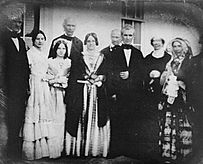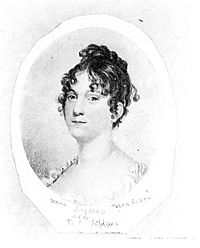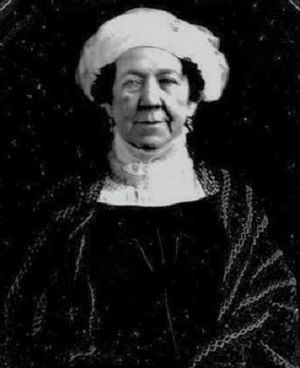Dolley Madison facts for kids
Quick facts for kids
Dolley Madison
|
|
|---|---|

Portrait by Gilbert Stuart, 1804
|
|
| First Lady of the United States | |
| In role March 4, 1809 – March 4, 1817 |
|
| President | James Madison |
| Preceded by | Martha Randolph (acting) |
| Succeeded by | Elizabeth Monroe |
| Personal details | |
| Born |
Dolley Payne
May 20, 1768 Guilford County, North Carolina, British America |
| Died | July 12, 1849 (aged 81) Washington, D.C., U.S. |
| Resting place | Montpelier, Virginia, U.S. 38°13′07.5″N 78°10′06.0″W / 38.218750°N 78.168333°W |
| Spouses |
John Todd
(m. 1790; died 1793) |
| Children |
|
| Signature | |
Dolley Todd Madison (born Payne; May 20, 1768 – July 12, 1849) was the wife of James Madison. He was the fourth president of the United States from 1809 to 1817. Dolley Madison was famous for hosting social events in Washington, D.C. She invited people from different political groups. This helped leaders from opposing sides talk and work together peacefully. Before her, political meetings could be very tense.
Dolley Madison also helped decorate the new White House. When the British attacked Washington in 1814, she famously saved a famous painting of George Washington. She told her enslaved servant, Paul Jennings, to save it. After her husband died, she faced financial struggles. She sold her home and her husband's papers to pay off debts. Historians often rank Dolley Madison as one of the most important and respected First Ladies.
Contents
Early Life and First Marriage
Dolley Payne was born on May 20, 1768, in a log cabin in New Garden, Guilford County, North Carolina. Her parents, Mary Coles and John Payne Jr., were from important families in Virginia. They were also members of the Quaker faith. Quakers believe in peace and simple living. Dolley grew up on a farm in Virginia and had a strict Quaker education.
When Dolley was 15, her family moved to Philadelphia, which was a large city at the time. Her father tried to start a business, but it failed. He died in 1792. Dolley's mother then opened their home as a boardinghouse to earn money.
Before her father died, he arranged for Dolley to marry John Todd. He was a lawyer from Philadelphia. They married on January 7, 1790, at a Quaker meeting house.
Marriage and Family Life
Dolley and John Todd had two sons: John Payne (called Payne) and William Temple. Their marriage was a happy one.
In 1793, a serious yellow fever outbreak hit Philadelphia. Many people died, including Dolley's husband, John, and their younger son, William. She also lost her mother-in-law and father-in-law. This was a very difficult time for Dolley. She was left to care for her surviving son, Payne, without much money. A lawyer named Aaron Burr helped her with legal advice during this time.
Second Marriage to James Madison
Soon after, Dolley Todd met James Madison. Aaron Burr, who was a friend to both, helped them meet. In May 1794, Burr formally introduced Dolley to James Madison. He was 43 years old and had never married. Dolley was 26.
They quickly fell in love and married on September 15, 1794. Because James Madison was not a Quaker, Dolley was no longer a member of the Quaker faith. She then started going to Episcopal church services. They lived in Philadelphia for three years.
In 1797, James Madison left politics for a while. He moved with Dolley, her son Payne, and their enslaved people to his family's plantation, Montpelier, in Virginia. They made their house bigger and settled in.
When Thomas Jefferson became president in 1800, he asked James Madison to be his Secretary of State. James accepted, and the family moved to Washington, D.C. Dolley believed that hosting parties would be important in the new capital city.
Life in Washington (1801–1817)
Dolley Madison worked with an architect named Benjamin Henry Latrobe to help furnish the White House. This was the first official home for the president. Since President Jefferson was a widower, Dolley often helped him host official events. She became a very important part of Washington's social life. She made friends with the wives of many diplomats. Her charm even caused a small diplomatic problem once!
In 1808, James Madison was chosen to run for president. He won and became the fourth President of the United States. He served two terms, from 1809 to 1817. Dolley Madison became the official White House hostess. She had already been an unofficial hostess during Jefferson's time.
Dolley helped define the role of the president's wife. She decorated the White House and welcomed many visitors. She was known for her kindness and hospitality. This helped her husband become more popular as president. She was the only First Lady to be given a special seat in Congress. She was also the first American to reply to a telegraph message. In 1812, James Madison was re-elected. Later that year, the War of 1812 began.
Saving the George Washington Portrait (1814)
In 1814, British forces attacked Washington, D.C. As they got closer, the White House staff quickly prepared to leave. Dolley Madison ordered Paul Jennings, her enslaved servant, to save a famous painting of George Washington. This painting was a copy of the Lansdowne portrait.
Many stories from that time said Dolley herself removed the painting. This made her a national hero. However, Paul Jennings later wrote that Dolley ordered him to save it. He said that Jean Pierre Sioussat and a gardener named McGraw actually took the painting off the wall. Historians now agree that enslaved servants were the ones who truly saved the painting.
Dolley Madison quickly left in her carriage with other families. They went to Georgetown and then crossed into Virginia. When the Madisons returned to Washington, the White House was badly burned. They had to live in The Octagon House instead.
Life at Montpelier (1817–1837)
On April 6, 1817, James and Dolley Madison returned to their plantation, Montpelier, in Virginia. This was one month after James retired from being president.
In 1830, Dolley's son, Payne Todd, had many debts. The Madisons had to sell land and mortgage part of Montpelier to pay his debts.
James Madison died at Montpelier on June 28, 1836. He was 85 years old. Dolley stayed at Montpelier for another year. She spent this time organizing and copying her husband's important papers. Congress later paid her for these papers, which included James Madison's notes from the 1787 convention.
In 1837, Dolley Madison moved back to Washington, D.C. She left Payne Todd in charge of the plantation. She moved into a house on Lafayette Square with her sister Anna. Dolley brought Paul Jennings with her as a butler. He had to leave his wife and children behind in Virginia.
Later Years in Washington (1837–1849)
While Dolley Madison lived in Washington, Payne Todd struggled to manage the Montpelier plantation. Dolley tried to sell more of her husband's papers to raise money, but she couldn't find a buyer.
Paul Jennings tried to buy his freedom from Dolley. She had written a will in 1841 that would free him after her death. But in 1846, she sold him to an insurance agent for $200. Six months later, Senator Daniel Webster bought Jennings from the new owner and gave him his freedom. Jennings later repaid the senator by working for him. Dolley eventually sold Montpelier, the remaining enslaved people, and the furniture to pay off her debts.
In 1848, Congress agreed to buy the rest of James Madison's papers for a large sum of money.
In 1845, Dolley Madison was baptized into St. John's Episcopal Church in Washington, D.C.
On February 28, 1844, Dolley Madison was with President John Tyler on a ship called the USS Princeton. A large cannon exploded, killing several people. President Tyler and Dolley Madison were unharmed.
Dolley Madison was photographed at least four times. This makes her the earliest First Lady for whom photographs still exist. Three photos were taken on July 4, 1848. The last one was taken in 1849 with President James Polk, his wife Sarah Polk, and others.
Dolley Madison died at her home in Washington in 1849, at 81 years old. She was first buried in Washington, D.C., but later moved to Montpelier to be buried next to her husband.
Honors and Legacy

During World War II, a ship called the SS Dolly Madison was built and named in her honor.
In 2000, Dolley Madison was part of the first group of women honored in Virginia Women in History.
Spelling of Her Name
For a long time, people thought Dolley's first name was Dorothea or Dorothy, and that "Dolley" was just a nickname. However, her birth was recorded as "Dolley." Her will from 1841 also says "I, Dolly P. Madison." Based on old documents, it seems her given name was "Dollie" or "Dolley." Newspapers and magazines often spelled it "Dolly."
In Movies and Books
- The Buccaneer (1938 film), played by Spring Byington
- Magnificent Doll (1946 film)
- Dolley: A Novel of Dolley Madison in Love and War (1994 book) by Rita Mae Brown
- A Dolley Madison commemorative silver dollar was made in 1999.
Regard by Historians
Since 1982, the Siena College Research Institute has asked historians to rank American First Ladies. They look at things like their intelligence, courage, and what they achieved. Dolley Madison has always been ranked among the top six First Ladies.
In these surveys, she has been ranked:
- 4th-best in 1982
- 4th-best in 1993
- 3rd-best in 2003
- 6th-best in 2008
- 4th-best in 2014
In the 2008 survey, Dolley Madison was ranked very high in all areas. She was 4th for her value to the country and 5th for her public image. In the 2014 survey, Dolley and James Madison were ranked as the 5th-highest "power couple" among all First Couples.
Images for kids
See also
 In Spanish: Dolley Madison para niños
In Spanish: Dolley Madison para niños




